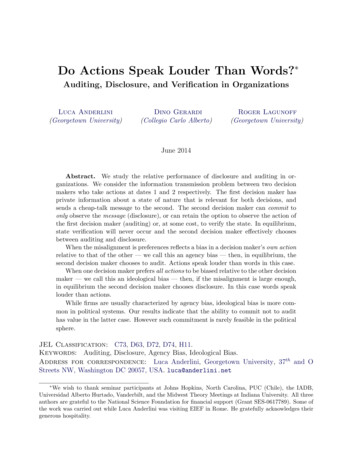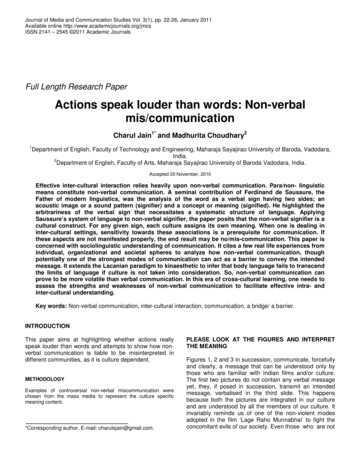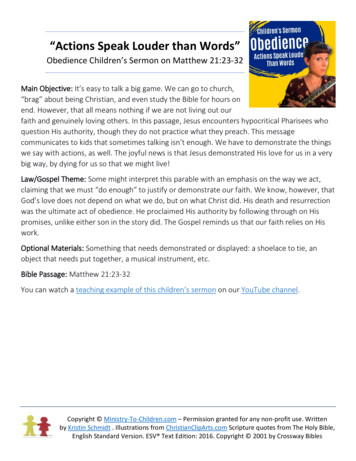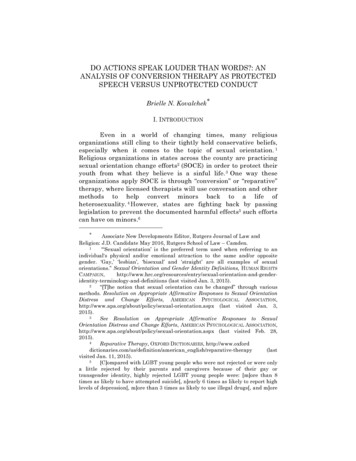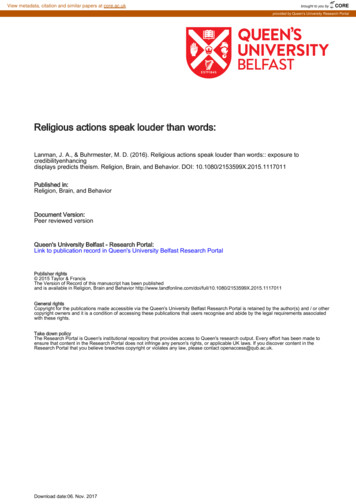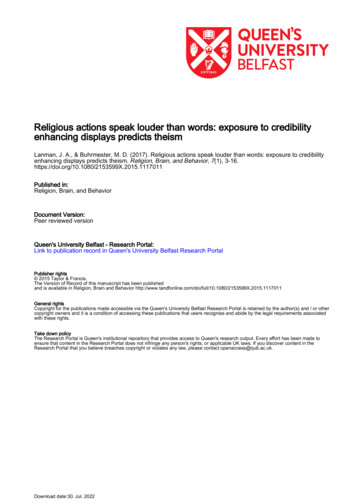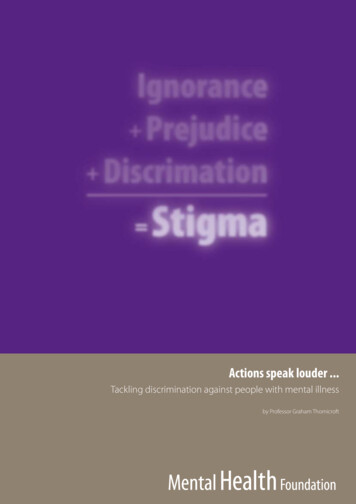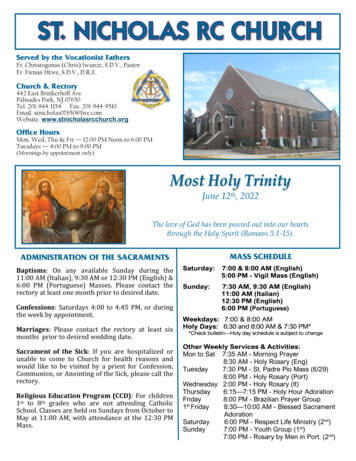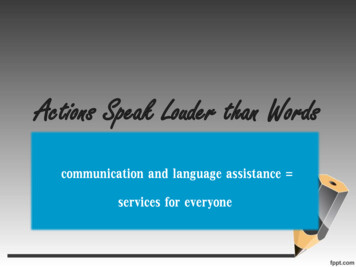
Transcription
Actions Speak Louder than Wordscommunication and language assistance services for everyone
Objectives Define communication and articulate theimportance of communication in human services. Explore how limited English proficiency impacteffective communication. Tools and techniques that help crosscommunication barriers Ways to plan for effective communication
How do we define communication? Direct meetings and conversationsOur dress, body language, andgreetingsTelephone, e-mail, memos, andlettersBrochures (ours and others weshare with individuals we serve)How we interpret plans, orders,directions, or decisionsInformation on websitesReferrals to or from other servicesNavigation around facilitiesEvery wayin which wediscuss,receive, orconveyinformation
It’s Important! Effective communication can help leadto positive outcomes Better use of the system Fairer outcomes Quicker resolution Stronger relationships Poor communication can encouragenegative outcomes Misunderstandings of what is needed Individual difficulty in followinginstructions Understanding of plans and,ultimately, both the actual andperceived fairnessHRSA
It’s Important! Demographic Changes Over 350 languages are spoken in the U.S. More than 47 million speak a language otherthan English Over 30 million who were born outside theUnited States Over 17% of the nation’s population speak alanguage other than English at home. Virginia is one of the top 15 states for ng-of-languages
What is Linguistic Competence?The capacity of an organization and itspersonnel to communicate effectively,and convey information in a mannerthat is easily understood by diverseaudiences including persons of limitedEnglish proficiency, those who have lowliteracy skills or are not literate, andindividuals with disabilities.National Center for Cultural Competence
Civil Rights Actof 1964The Civil Rights Act of1964 says that noperson shall beexcluded fromparticipation in, bedenied the benefits of,or be subjected todiscrimination based onrace, gender, ethnicityor national origin underany program or activityreceiving Federalfinancial assistance."Organizations are required to takereasonable steps to ensure meaningfulaccess to their programs and activitiesby LEP persons.The Guidance explains that the obligationto provide meaningful access is factdependent and starts with anindividualized assessment thatbalances four factors:1.2.3.4.Title VI FilmNumber or Proportion of LEPIndividualsFrequency of Contact With theProgramNature and Importance of theProgramResources Available
Americans with Disabilities ActDOJ regulationsstate that publicentities must “takeappropriate steps toensure thatcommunicationswith applicants,participants, andmembers of thepublic withdisabilities are aseffective ascommunicationswith others.” 28C.F.R. § 35.160(a).The public entitymust “furnishappropriate auxiliaryaids and serviceswhere necessary toafford an individualwith a disability anequal opportunityto participate in, andenjoy the benefits of,a service, program,or activity conductedby a public entity.”28 C.F.R. §35.160(b).The public entitymust also give“primaryconsideration” to theindividual’spreference withrespect to choosingthe type of auxiliaryaid or service toprovide to ensureeffectivecommunication. 28C.F.R. § 35.160(c).
What are Language AccessServices?Individuals Right to KnowInterpretingTranslationAssistive Technology/Communication ToolsSignageWay-findingCommunity InvolvementTraining
TeamSTEPPS 2006Youdelman, Mara and Jane Perkins. 2002. ProvidingLanguage Interpretation Services in Health CareSettings: Examples from the AudioPlayer/AudioPlayer.asp?AudioFileName 17 3-4-2.mp3Federal Compliance Consulting LLC and Bruce L. Adelson,2013Speaking inTonguesVideoGrave ConsequencesI would tell thedoctor’okay,’ but I didn’tunderstand anything[about taking mymedications].’
Individual’s Right to Know
Untrained Interpretershttps://www.youtube.com/watch?v R2NcwrPZBLM&list FLfRTUEdkhoIhvlHPGSUXbIg&index 53 52% Omission 16% FalseFluency 13%Substitution 10%Editorializaiton 8% AdditionSource: Errors in Medical Interpretation and Their Potential Clinical Consequences in Pediatric Encounters. Flores, et al, Pediatrics 2003
Trained Interpreters National Cancer Institute study Trained interpreters: Accurately interpreted most (74%) of theconversation(Range: 47%-98%) Had higher accuracy during non-technicalDanielle E Rose, Diana M Tisnado, Jennifer L Malin, May L Tao, Melinda A Maggard, John Adams, Patricia AGanz, Katherine L Kahn. 2010.
Children as Interpreters
Translation What languages?Who can do this?Costs?Who can reviewthis? Who cancoordinate? What aboutforms?Language SupportDarci L. Graves, MA, MA - University of Maryland-Baltimore County
Graphic Material
PLANNING FOR EFFECTIVECOMMUNICATION
What makes an organization linguisticallycompetent?Offer TTYand otherassistivetechnologydevicesDo wehaveUsepolicies inOfferPrintqualifiedplacematerials inmaterials intranslationregardingAlternativeeasy toservicesthe use offormatsread,interpreters especially(e.g.,low literacy,audiotape,and trainforpicture andBraille,staff onlegallysymbolenlargedhow tobindingformatsprint )access and documentswork withthem.Understandhow andwhenlanguageselectionhappens forindividualswho speakmore thanonelanguage.
Sustaining Language Access Services
Identify IndividualResponsibleConvene workinggroup (authority,some knowledge ofthe issues, interestand ability toaccomplish tasks)Systematicallyaddress translation,interpretation,outreach, andevaluationTake a walk in theshoes of anindividual withcommunicationbarriersDeveloping aLanguageAccess PlanIdentifyareas/departmentsimpactedLanguage Needs andStaff CapacityAssessments(VDH, US Census,Org Data)ReadinessAssessment (IdentifyEnablers & Barriers)
Creating Your Language Services Toolbox
LANGUAGE ACCESS COORDINATORSample Duties Identify qualifiedinterpreters andtranslators to be includedin interpreter database; Create interpreter,bilingual staff, andtranslator qualificationsstandards; Outline measures toensure quality control ofinterpreters andtranslators; Develop a pay structurefor contract language Train and test or contractwith appropriate agenciesto train and test bilingualindividuals including staffwho perform languageassistance services; Develop a procurementstrategy for contractlanguage assistanceservices providers. Provide input in budgetaryand procurement mattersrelated to implementationof the language accesspolicy, plan, andprocedures;
LAP Template IntroductionPurposeIdentification of CoordinatorLanguage Access Needs AssessmentLanguage Resources AssessmentLanguage Service ProtocolsVital Document TranslationsStakeholder ConsultationsStaff TrainingNotice to PublicAgency Monitoring
Resources National Standards for Culturally and Linguistically Appropriate ntent/clas.aspCenter for Plain Languagehttp://centerforplainlanguage.orgLEP Federal Interagency Websitehttp://www.lep.govNational Center for Cultural chd/ncccHealth Resources and Services lthliteracy/DHHS Office of Minority Healthhttp://minorityhealth.hhs.gov/SAMHSA Office of Behavioral Health Equityhttp://www.samhsa.gov/about/obhe.aspx
Actions Speak Louder than Words communication and language assistance services for everyone . . Over 17% of the nation's population speak a language other than English at home. Virginia is one of the top 15 states for refugee . National Cancer Institute study Trained interpreters: Accurately interpreted most (74%) of the
